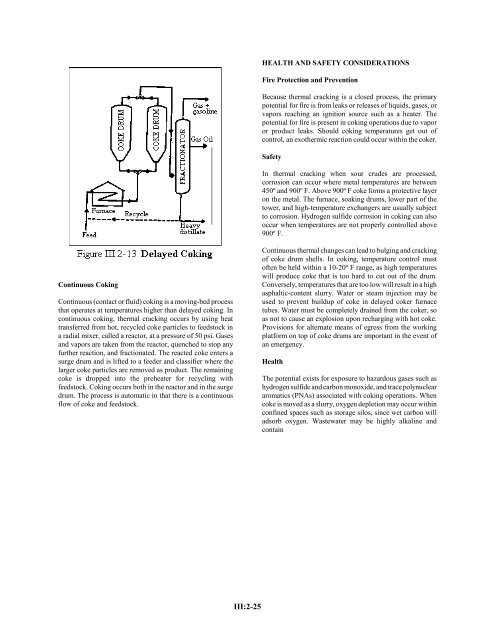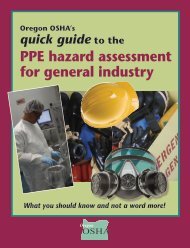Technical Manual - Section 3 (Safety Hazards)
Technical Manual - Section 3 (Safety Hazards)
Technical Manual - Section 3 (Safety Hazards)
You also want an ePaper? Increase the reach of your titles
YUMPU automatically turns print PDFs into web optimized ePapers that Google loves.
HEALTH AND SAFETY CONSIDERATIONS<br />
Fire Protection and Prevention<br />
Because thermal cracking is a closed process, the primary<br />
potential for fire is from leaks or releases of liquids, gases, or<br />
vapors reaching an ignition source such as a heater. The<br />
potential for fire is present in coking operations due to vapor<br />
or product leaks. Should coking temperatures get out of<br />
control, an exothermic reaction could occur within the coker.<br />
<strong>Safety</strong><br />
In thermal cracking when sour crudes are processed,<br />
corrosion can occur where metal temperatures are between<br />
450º and 900º F. Above 900º F coke forms a protective layer<br />
on the metal. The furnace, soaking drums, lower part of the<br />
tower, and high-temperature exchangers are usually subject<br />
to corrosion. Hydrogen sulfide corrosion in coking can also<br />
occur when temperatures are not properly controlled above<br />
900º F.<br />
Continuous Coking<br />
Continuous (contact or fluid) coking is a moving-bed process<br />
that operates at temperatures higher than delayed coking. In<br />
continuous coking, thermal cracking occurs by using heat<br />
transferred from hot, recycled coke particles to feedstock in<br />
a radial mixer, called a reactor, at a pressure of 50 psi. Gases<br />
and vapors are taken from the reactor, quenched to stop any<br />
further reaction, and fractionated. The reacted coke enters a<br />
surge drum and is lifted to a feeder and classifier where the<br />
larger coke particles are removed as product. The remaining<br />
coke is dropped into the preheater for recycling with<br />
feedstock. Coking occurs both in the reactor and in the surge<br />
drum. The process is automatic in that there is a continuous<br />
flow of coke and feedstock.<br />
Continuous thermal changes can lead to bulging and cracking<br />
of coke drum shells. In coking, temperature control must<br />
often be held within a 10-20º F range, as high temperatures<br />
will produce coke that is too hard to cut out of the drum.<br />
Conversely, temperatures that are too low will result in a high<br />
asphaltic-content slurry. Water or steam injection may be<br />
used to prevent buildup of coke in delayed coker furnace<br />
tubes. Water must be completely drained from the coker, so<br />
as not to cause an explosion upon recharging with hot coke.<br />
Provisions for alternate means of egress from the working<br />
platform on top of coke drums are important in the event of<br />
an emergency.<br />
Health<br />
The potential exists for exposure to hazardous gases such as<br />
hydrogen sulfide and carbon monoxide, and trace polynuclear<br />
aromatics (PNAs) associated with coking operations. When<br />
coke is moved as a slurry, oxygen depletion may occur within<br />
confined spaces such as storage silos, since wet carbon will<br />
adsorb oxygen. Wastewater may be highly alkaline and<br />
contain<br />
III:2-25
















